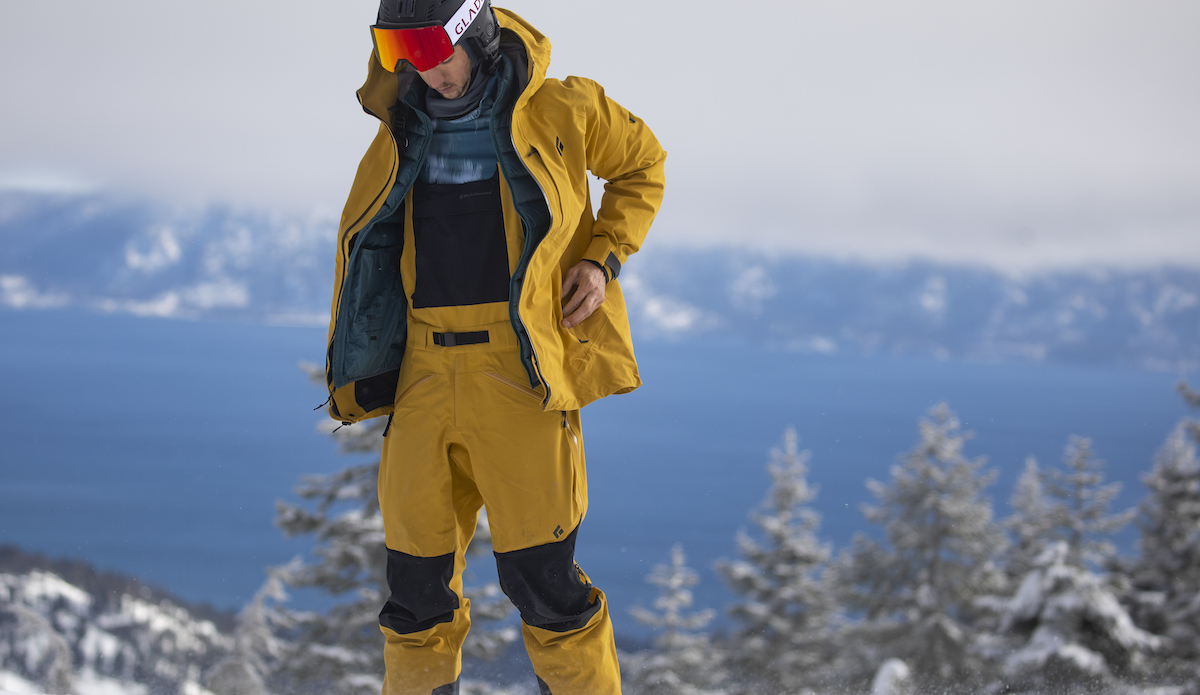
The Black Diamond Recon Stretch Bibs don’t skimp on functionality or durability. Photo: Ryan Salm/The Inertia
Here at The Inertia, we’re of the opinion that there’s basically no reason to ski in pants instead of bibs. Even when heading out into the backcountry. Getting snow in your ski pants sucks. Ski bibs fix that. Ski bibs add a ton of pocket space. They also reduce unnecessary layer-bunching at the waist, and they sure look good, too. Sure, bibs generally run warmer than pants and may add a bit of weight on the uphill (we’re certainly not gram-counters), but in our opinion, the pros vastly outweigh the cons. And there are plenty of bibs on the market today that are just as lightweight and breathable as a pair of ski pants.
Gear Editor Will Sileo hasn’t skied in pants in years, and in that time he’s tried a lot of different bibs from longstanding brands like The North Face, Black Diamond, and Mountain Hardwear, as well as up-and-coming favorites like Trew Gear, Flylow, Stio, and Strafe. We’ve done our time in them on the resort, in the backcountry, and yes, even at the aprés-scene. And as you might imagine, we’ve got some things to say about them. A whole article-full, actually.
Read on for our top picks for ski bibs. To see them side-by-side, check out our Comparison Table, and for more information check out our Buyer’s Guide. To complete the look, here’s our guide to The Best Ski Jackets, and for women, check out our guide to The Best Women’s Ski Bibs.
The Best Ski Bibs of 2024
Best Overall/Best Resort Ski Bibs: Flylow Baker Ski Bibs
Best Resort/Backcountry Ski Bibs: Backcountry Cardiac GORE-TEX Pro Bib
Best Backcountry Ski Bibs: Mountain Hardwear High Exposure
Best Budget Ski Bibs: Mountain Hardwear Firefall/2 Insulated Bib
Most Stylish Ski Bibs/Runner-Up Best Overall: Trew Gear Trewth Bib Primo
Best Overall Ski Bibs
Flylow Baker Ski Bibs ($430)
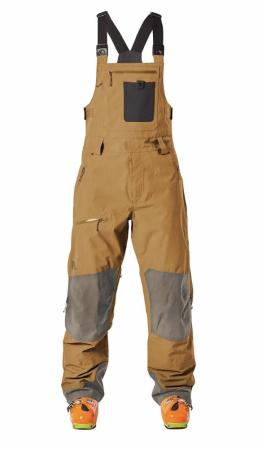
Shop Men’s | Shop Women’s (Moxie)
Weight: 907g
Best For: Resort/backcountry
Pros: Tons of pockets, heavy-duty material, great ventilation
Cons: Buckles for suspender straps can be a pain point with backpacks, very popular design
The Flylow Baker bibs have been at the top of this list for a while, and no other bib has yet to come close in terms of their fully-featured awesomeness, style, and versatility. With tons of pockets, good venting, and insane durability, these “workwear-inspired” bibs can really do it all. They’re a bit heavier and stiffer than many options on this list, but that sacrifice is well worth it for ridiculously-tough material that has stood up to the test of time. They’re listed as a 50/50 resort and backcountry bib, and while we’d say they definitely lean more towards the resort side of the spectrum, they can take on the backcountry as well. We love that the bibs have both inner and outer thigh vents, which compensate for the less breathable material by allowing cross-ventilation. However, for longer tours, you’re going to be happier in something lighter.
We also tested the Flylow Baker Perm Bib ($520), which has all the incredible features of the regular Bakers, with a more air-permeable and lighter material. If you plan on getting out into the backcountry a decent bit, the Baker Perms are well worth the upgrade. If not, the tried and true Bakers are where it’s at for the increases in durability and warmth.
The one and only downside we’ve found is the buckles for the suspenders. They’re a bit chunky and can be a little uncomfortable when worn with a backpack, but with a couple layers on top, it’s not an issue. The Flylow Bakers are a men’s-cut bib, and the women’s versions are called the Flylow Moxie and Flylow Foxy. The Foxy is a tighter-fitting version, and the Moxie is a bit roomier.
CHECK PRICE ON REI CHECK PRICE ON Amazon
Best Resort/Backcountry Ski Bibs
Backcountry Cardiac GORE-TEX Pro Bib ($550)
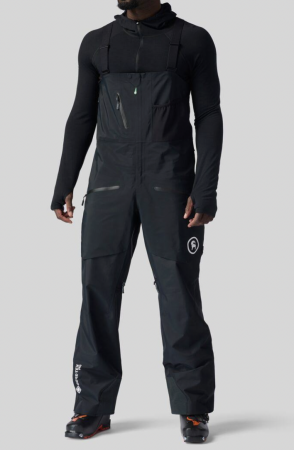
Best For: Backcountry/resort
Weight: 686 g
Pros: Durable and lightweight construction, great ventilation
Cons: Material is not as breathable as most backcountry-oriented bibs
Backcountry ski bibs have a tricky balance to strike. They must be lightweight and breathable for the uphill, but burly enough to keep you protected from inclement weather should things get nasty, and be able to stand up to the rigors of the downhill for many seasons to come. Backcountry’s Cardiac Bibs (updated this 23/24 season) strikes such a balance with ease, with super-rugged GORE-TEX Pro material.
It’s not the most breathable material, but these bibs make up for it with both interior and exterior ventilation, allowing the user to get a full cross-breeze going down below. This is a winning combo for backcountry use, letting you really open things up on the uphill to keep from overheating, but should the nasty weather arrive, or you find yourself bushwhacking, these bibs won’t let you down as some lighter and more breathable bibs might in such conditions.
Fully zipped up, you won’t be getting the breathability of a lightweight bib. As such these wouldn’t be our first pick for a lightweight spring-touring bib aimed at corn-harvesting laps. However, they’ll certainly suffice in such conditions if you’re looking for a one-bib-to-do-it-all solution. The burly material is also plenty durable enough to stand up to the rigors of resort-skiing, though you’ll certainly want to layer-up underneath on the colder days.
CHECK PRICE ON BACKCOUNTRYBest Backcountry Ski Bibs
Mountain Hardwear High Exposure ($450)
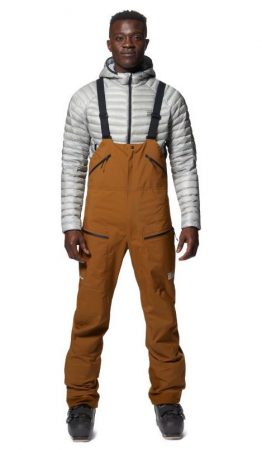
Weight: 390g
Best For: Backcountry
Pros: Very lightweight and breathable, but storm-ready material
Cons: Not the most durable construction
Mountain Hardwear’s offering in the lightweight touring bib category is the bib for those who couldn’t decide between a softshell or a hardshell. These bibs are made of a thin and super light material that, despite being GORE-TEX, has great breathability, helped by full side zips for ventilation. That said, they’re in no way a soft shell and are fully capable of repelling snow, rain, and harsh weather with ease.
Four pockets provide plenty of room for essentials, and the straps are low-profile and comfortable. Our main concern is the bibs’ long-term durability due to the thin material, but it has, almost surprisingly, stood up to multiple seasons of mixed resort/backcountry use without any signs of wear. That said, if you’re looking for a bib that will stand up to long-term resort use, the 40-Denier fabric of these bibs simply won’t bear the same amount of abuse as higher-Denier fabrics like the 150-D fabric of the Flylow Bakers.
CHECK PRICE ON Mountain Hardwear CHECK PRICE ON REI
Best Budget Ski Bibs
Mountain Hardwear Firefall/2 Insulated Bib ($229)
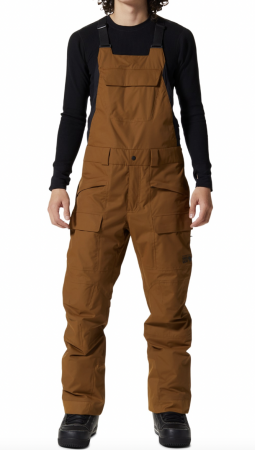
Best For: Resort
Weight: 816 g
Pros: Durable, insulated bibs at an incredible price with a full feature-set
Cons: Runs warm, slim fit
Interested in a fully-featured, insulated bib at an incredible price? Look no further. Mountain Hardwear’s Firefall/2 Insulated Bib hits all the right marks, at a hard-to-believe price. The competition for “Best Budget Ski Bib” is stiff. What elevated this bib above the rest were the well-thought-out features, ample ventilation, and durable construction. The bibs sport a whopping six pockets, two knee-length side zippers for ventilation (as well as easier bathroom breaks), 60 g of synthetic insulation in the knees and seat, and a durable, 2L waterproof shell material that will last many seasons to come.
The main drawback is that the 60 g insulation will have you running fairly hot on warmer days, so these wouldn’t be our first choice for spring skiing (and certainly are not a winner for the backcountry). The fit is also fairly slim, a con for those looking for that baggy “freeride” fit, or those with larger frames. These factors somewhat reduces the bibs’ versatility, but for those interested in a mid-winter bib at an incredible price, you can’t get much better than this one.
CHECK PRICE ON REI CHECK PRICE ON Amazon
Most Stylish/Runner-Up Best All-Around Ski Bibs
Trew Gear Trewth Bib Primo ($500)
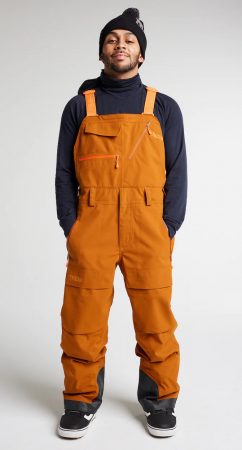
Shop Men’s | Shop Women’s (Chariot)
Weight: 870 g
Best For: Resort
Pros: Great pockets, lightweight material, wide selection of colors
Cons: Roomy fit
Trew Gear has been making a name for itself recently with its fully-featured bibs that come in a variety of fun colors, and its flagship model, the Trewth Bib Primo, lives up to the hype with plenty of pockets, great style, and very durable 20k/20k waterproof/breathable fabric made from recycled nylon. One cool feature is that every zippered pocket has a small attachment point for a beacon leash, phone leash, or anything else you don’t want to lose. They’re described as a bib for both resort and backcountry, and while we’d agree they’re certainly up to both, the resort is where they truly thrive.
Of note is the roomy fit. With these bibs, pay attention to the size chart, and when in doubt, size down. Our tester is normally a medium in bibs but found himself swimming in a size medium Trewth bib. However, short and tall sizes to the rescue! Trew, unlike most bibs here on this list, offers short and tall cuts for every size of bib they offer, and the small-tall size fit our tester great, accommodating his lanky frame. They still had that roomier fit to them, but we’ve realized that’s just part of that freeride style. Trew’s offering of these bibs in both short and tall sizes is great for dialing in the fit to the max, and they even have an extended version.
Side Note: if you’re looking to purchase a full set of jacket and bibs for maximum style points, Trew has a matching jacket for every pair of bibs they sell.
CHECK PRICE ON Trew CHECK PRICE ON Evo
Best of the Rest
Runner-Up Best Backcountry/Resort Ski Bib
Strafe Outerwear Nomad Bib ($599)
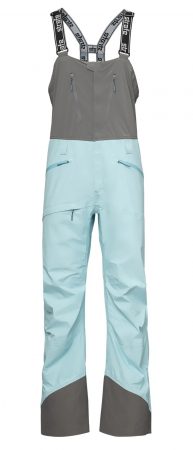
Shop Men’s | Shop Women’s (Scarlett)
Weight: 695 g
Best For: Backcountry/resort
Pros: Lightweight and fully-featured bibs for a mix of resort and backcountry use
Cons: Lightweight construction isn’t the most durable, and runs a bit cold for resort use
Strafe Outerwear is a brand that’s recently come onto our radar, and we’re very glad that they did. Their Nomad kit (jacket and bibs) strikes an incredible balance of lightweight and breathable material that is well-prepared to stand up to inclement weather and the rigors of resort use. It’s not as durable as some materials that we have experienced in our testing, but it will certainly do the trick, and the trade-offs of lightweight breathability and easy movement are well-worth it if you’re looking for a bib that will excel in resort and backcountry skiing.
These bibs do run a good bit colder than your classic resort-oriented bib due to the increased breathability, but that’s easily fixed by layering up underneath, and the “freeride” (aka: roomy) fit provides plenty of room for layering without decreasing mobility. Other outstanding features include a super-breathable and stretchy bib upper, plenty of pockets (with internal organization!), reinforced scuff-guards, and a comfortable suspender-strap system.
CHECK PRICE ON StrafeRunner-Up Best Budget
The North Face Freedom Bib ($250)
Best For: Resort
Weight: 935 g
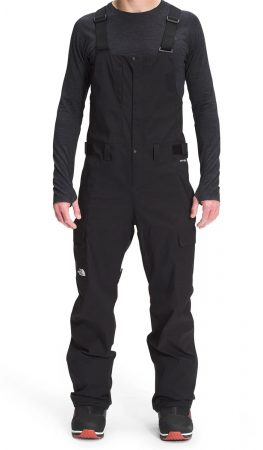
Pros: Well-featured bibs at a great price
Cons: Some budget-feeling features, minimal ventilation, slim fit
The North Face is by no means a budget brand, but it’s certainly a brand of the people and has produced some budget-friendly winners over the years. One such piece is TNF’s Freedom Bib, which has been keeping backsides warm and dry at an affordable price for many seasons. The fact that not much (if anything) has changed about the bib in the years it has been around speaks to its enduring appeal and bang-for-buck value.
For just $250, you get an un-insulated bib with plenty of pockets, comfortable suspender straps, durable fabric, some ventilation, as well as belt loops and velcro waist adjustments to dial in the perfect fit. The bibs are also offered in a variety of colors and sizes, so you can dial in your perfect ski kit. While it is not an insulated bib, it does run a good bit warmer than true 3L shell bibs due to the 2L construction and recycled polyester lining that has a fleecy feel to it.
What kept this bib away from the “Best Budget” top pick were a few things. First of all, the bib definitely has a bit of a budget feel to it, as it’s easy to see where some compromises were made to save a few bucks. The center front zipper is a one-way zipper, and starts at the top of the bib, making bathroom breaks more difficult as you’ll need to open the front of your jacket or awkwardly reach under and up to the top of the bib to unzip. Furthermore, the vertical chest-pocket has only a velcro closure, which had us a little worried about trusting it with something as valuable as one’s phone.
Finally, the ventilation could certainly be improved, especially for a warmer shell bib. While the bib is not really insulated, the liner adds some warmth, and with only interior-thigh ventilation zippers (that are mesh-lined, further cutting down on breathability) it can be hard to dump heat on warmer days. Vents on the exterior of the thighs tend to be better at getting rid of heat in a hurry. However, having interior and mesh-lined vents means you can keep them open while skiing without worrying (too much) about snow getting in, a definite plus.
CHECK PRICE ON REI CHECK PRICE ON Amazon
Another Overall Runner-Up
Black Diamond Recon Stretch ($450)
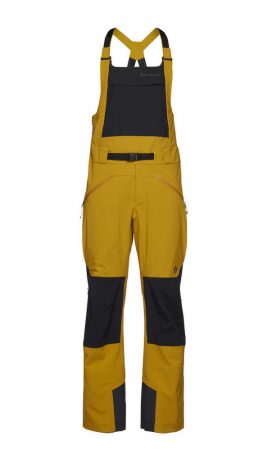
Weight: 913g
Best For: Resort/backcountry
Pros: Comfortable suspender straps, good pockets, bomber material
Cons: Material is heavier than most
Black Diamond has got a top-tier bib option with their Recon Stretch Bibs. The best part about them is that there’s really nothing to complain about. The straps are comfortable, and the quantity of pockets isn’t as legendary as the Flylow Bakers, but the two thigh pockets are deep, with a sleeve on the right side for organization, and the chest pockets are spacious, providing plenty of room to store essentials. The fit is awesome, and the stretchy material means these are exceedingly comfortable bibs that move with you in a way that many other bibs on this list don’t. Speaking of, the material was quite different from most options here, a stretchy but extremely durable and storm-ready construction.
The only hit that the bibs take is on weight. The material is burly and weighs as such, so these wouldn’t be our top choice for heading out on a longer tour or multi-day backcountry mission. However, for sidecountry and shorter, stormier tours, these perform admirably with the stretchy material, full side vents to dump heat, and a breathable upper-body construction. And on the resort, these will stand up to just about any abuse you can throw at them.
CHECK PRICE ON Black DiamondSustainable GORE-TEX
Patagonia Untracked Bibs ($650)
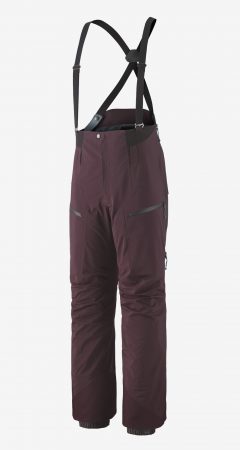
Shop Men’s | Shop Women’s
Weight: 650g
Best For: Resort/backcountry
Pros: Sustainable, storm-ready GORE-TEX protection
Cons: Pricey, pockets are sufficient but not a standout feature
Patagonia’s 2023/2024 Snow line just dropped, and with it, the Untracked outerwear kit (bib and jacket). We were lucky enough to get in these bibs before they released last season, and were impressed with what we found. The standout feature of these bibs is the sustainable GORE-TEX construction. GORE-TEX, while providing the gold standard in terms of durable, waterproof/breathable fabric, takes a toll on the environment, which is why Patagonia has always gone with their own in-house waterproof/breathable fabric made with more sustainable materials. For 2023/24, the two snowsports giants have come together to produce a PFC-free and 100% recycled GORE-TEX fabric that’s up to Patagonia’s rigorous environmental standards.
And the fabric performs. Super durable and capable of withstanding wet conditions, the fabric, with a light flannel backer, moved extremely well, both on the resort and for colder backcountry expeditions. The fabric wasn’t the most breathable we’ve tried, and ran a bit warmer due to the flannel backer, landing this bib a little further on the resort side of the spectrum, though for colder, stormier tours, this bib certainly is up to the task. Features-wise, the bibs have two deep pockets, and a low-rise bib that sits fairly snug, keeping snow out despite the low coverage. The suspender straps are extremely low-profile as to be almost unnoticeable. The bibs also feature a Recco Reflector, which aids professionals in finding you should an emergency arise, and are backed by Patagonia’s Ironclad Guarantee — if you break it, they’ll fix it. Classy, bombproof and sustainable, the only things that kept this bib from hitting top marks were the high price, and lack of pockets.
CHECK PRICE ON PATAGONIAAnother Awesome Backcountry Bib
Outdoor Research Skytour Ascentshell ($400)
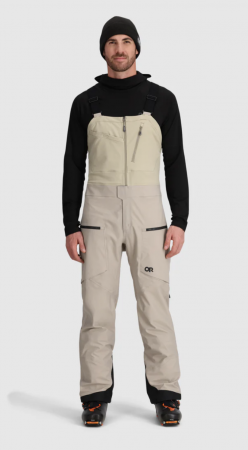
Shop Men’s | Shop Women’s
Weight: 768g
Best For: Backcountry/resort
Pros: Super breathable and stretchy material
Cons: Some complaints about extra material in the back
Don’t get us wrong; these are a worthy pair of bibs, and a top contender for the Best Backcountry Ski Bibs award, with solid resort-durability credentials to boot. There are plenty of well-planned pockets with internal loops for a beacon and other essentials, and other great features like a full dropseat, power strap slots on the snow gaiters and durable scuff pads at the ankles. And all that at $400. Impressive.
The bibs are made of OR’s AscentShell fabric, a very stretchy hardshell material that’s so breathable it borders on being a softshell while still repelling snow and rain. It’s fairly sturdy as well, but a bit heavier than the materials used in the Arc’teryx Rush and the Mountain Hardwear High Exposure above. It’s also worth noting that the breathability comes at the cost of some wind protection. That said, the increase in “wind protection” in the Rush and High Exposure bibs comes at the cost of some breathability. So pick your poison.
For us, what pushed this pair of bibs down the list was the fit. The upper “bib” part of the piece has a decent bit of extra fabric in the back area, which can be a bit uncomfortable under additional layers or when combined with a backpack. Our tester’s skinny build wasn’t doing him any favors in this area, but in reading other reviews and comments online, we realized he wasn’t the only one with this problem.
CHECK PRICE ON Outdoor ResearchRemovable Bib Upper
Mammut Haldigrat ($440)
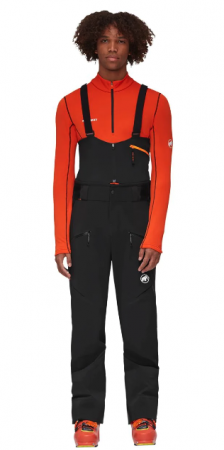
Shop Men’s | Shop Women’s (La Liste)
Weight: 496g
Best For: Backcountry/resort
Pros: Removable bib upper
Cons: Very trim fit
Mammut threw an interesting features into this pair of bibs that some will love, and some might turn their nose up at, which is a removable bib upper, which can be zipped off, turning the bibs into a pair of pants. We thought it’s a pretty cool idea, especially if you’re someone who is interested in the added coverage of bibs but doesn’t want to completely give up skiing in pants.
As far as construction goes, the Haldigrat bibs feature a durable, waterproof material that is also fairly lightweight and breathable, similar to the Ortovox Deep. However, this lightweight and breathable fabric does run a little cold, requiring extra layers for cold resort-skiing days.
Style-wise, these weren’t a top pick due to that removable bib upper and what we’d describe as a fairly trim “euro” cut. Otherwise, these are a well-made bib with a rad new feature in the removable bib.
CHECK PRICE ON BackcountryLightweight, Full-Coverage Bib for Backcountry
Ortovox Deep ($650)

Shop Men’s | Shop Women’s
Weight: 664g
Best For: Backcountry/resort
Pros: Great coverage, light and comfortable material
Cons: Not enough pockets
The Ortovox Deep bibs strike a solid balance between lightweight backcountry breathability and resort riding toughness. The hardshell material is plenty thin and lightweight enough for touring but fairly sturdy. Nowhere near the toughness of the Flylow Bakers or the Trewth Bib Primo, but good enough for on-piste action.
The bibs feature a fairly trim cut. It’s described as “loose,” and while we agree it isn’t tight, loose might be a bit generous of a term. Velcro waist adjusters help dial in the fit. Suspenders are comfortable, both with and without a backpack, due to the minimal hard points.
We were a bit confused as to why the bibs didn’t have more pockets, however. There are two thigh pockets, which is great, but only one hip pocket (on the right leg) and one chest pocket (on the left side). We understand the weight reductions of extra fabric and zippers, but adding a symmetrical pocket on the chest and hip doesn’t feel like too big of a deal, and without them, it feels like a bit of wasted real estate. And as a leftie, our tester is accustomed to putting his phone in his left-hand hip pocket, and on these bibs, there isn’t one.
They do run a good bit warmer than the Arc’teryx Rush due to the full chest-length coverage and a few merino wool panels for warmth in key areas, but there is a more breathable stretch panel at the back, as well as full side zips down to the knees to help dump heat (and for full drop-seat functionality).
CHECK PRICE ON BackcountryThe North Face Summit Verbier ($550)
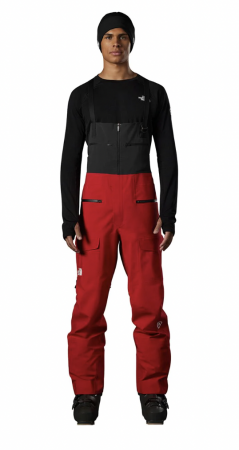 Weight: 857g
Weight: 857g
Best For: Resort/backcountry
Pros: Lots of pockets, warm but thin backing on inside of pant legs
Cons: On the heavier side
The North Face really came oh-so-close to resort-riding perfection with the Summit Verbier bibs. The pockets are great; there are six of them, three on each side, with plenty of room to keep essentials organized. The material is bomber, with great waterproofing. The bibs feature a flannel backer from the waist down to the calves, so breathability isn’t great, but the two side zips (that also allow for a full drop-seat) and inner thigh vents give plenty of ventilation when necessary. However, that lead us to classify this as a resort bib rather than a backcountry one. we were stoked on the small details like a small clip at the front of the gaiters to attach to boot laces should you find yourself wading through snow in your Sorels, internal pocket organizers, low-profile suspender straps, and stretchy, breathable material on the upper body to keep the bibs from running too hot.
Our one complaint was a minor one that probably won’t even be noticeable to most people. The suspender straps connect in the back with a very small piece of hard plastic that our lead tester had some trouble with getting to sit well on his very bony spine. It’s mostly a concern with backpacks and on warmer days when not running a midlayer between one’s shell and baselayer.
While they don’t come in the wide array of colors that the Trew bibs do (there are 3-4 color options total), if you’re looking to complete the look, The North Face’s Summit Verbier Jacket is a similarly awesome piece of gear with incredible pockets and that matches the bibs perfectly.
CHECK PRICE ON Backcountry CHECK PRICE ON The North Face
Arc’teryx Rush ($700)

Shop Men’s
Weight: 536g
Best For: Backcountry
Pros: Sleek and lightweight feel, great, low-profile suspender straps
Cons: Pricey, not the most breathable backcountry bib
The Arc’teryx Rush bibs deliver with a trim fit, low-profile suspender straps, durable materials, and four pockets. The material was a bit stiff at first but loosened up considerably after the first tour in them, and had a burly feel with the use of 70-denier GORE-TEX PRO Most Rugged material, which is noticeably tear-resistant, especially when compared with other backcountry-oriented bibs. Pockets are sufficient. Not a standout feature, but for a pair of backcountry-oriented bibs, the fact that they weren’t a “con” is notable.
Our favorite feature was the strap system, one of our favorite suspender straps among all bibs featured here. The small metal clips for attachment and adjustment were unnoticeable under a backpack (a pair of bibs’ greatest enemy).
Another favorite feature was the snow gaiters, which include protected openings that let you buckle a ski boot powerstrap over the gaiter for faster adjustments, but don’t let snow in while doing so. A few other bibs on this list also have this feature, like the OR Skytours.
On the breathability side of things, these bibs were solid but not a standout among competitors like the OR Skytours, where breathability is the top priority. The heavier-duty fabric made for a bit warmer of an experience on the uphill, and while the low-cut bib did keep the upper body cooler than full-cut bibs, the side zips for ventilation were average at best. But to be fair, it’s hard to have durable materials, light weight, and breathability at the same time. You’re going to have to sacrifice somewhere.
CHECK PRICE ON Arc'teryxREI First Chair GTX ePE ($270)
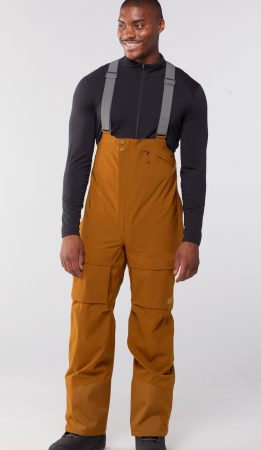
Shop Men’s | Shop Women’s
Weight: 847g
Best For: Resort
Pros: Great price, comfortable fit, recycled materials
Cons: 2L construction reduces breathability
For a reliable and cheap option that looks good, too, the REI First Chair GTX ePE bibs don’t disappoint. Three pockets provide decent room for essentials, and while they’re a 2L rather than 3L construction (see the buyer’s guide section below for more info on the difference), the use of GORE-TEX provides some added peace of mind in terms of durability and waterproofing. We did not find ourselves disappointed with the performance of the material while on the resort. Notably, the bibs shell and liner are made with recycled materials, and the GORE-TEX ePE membrane is a new, lower-impact technology that reduces the carbon footprint of the GORE-TEX manufacturing process.
Best of all, they’re exceedingly comfortable, and the hanging liner provides a bit of extra warmth for colder days on the mountain. With that in mind, these are certainly more of a resort bib than a backcountry one, although they sure won’t kill you on the odd tour or two. Priced at $270, they’re often to be found for much cheaper on REI.com.
CHECK PRICE ON REIBest Ski Bibs Comparison Table
| Bib | Price | Best For | Weight | Material/Waterproofing |
| Flylow Baker | $430 | Resort | 907 g | 3L Intuitive 20k/20k |
| Flylow Baker Perm | $520 | Resort/backcountry | 750 g | Perm HD 20k waterproofing |
| Backcountry Cardiac GORE-TEX Pro Bib | $550 | Backcountry/resort | 686 g | 3L GORE-TEX Pro |
| Mountain Hardwear High Exposure | $450 | Backcountry | 390 g | 3L GORE-TEX C-KNIT |
| Mountain Hardwear Firefall/2 Insulated | $229 | Resort | 816 g | 2L waterproof Dry.Q |
| Trew Gear Trewth Bib Primo | $500 | Resort | 870g | 20k/20k 3L PNW Primo |
| Strafe Outerwear Nomad Bib | $599 | Backcountry/Resort | 695 g | eVent DV Alpine 3L ripstop |
| The North Face Freedom Bib | $250 | Resort | 935 g | 2L DryVent |
| Black Diamond Recon Stretch | $450 | Resort/backcountry | 913 g | 20k/20k Bd.dry stretch |
| Patagonia Untracked Bibs | $650 | Resort/backcountry | 650 g | 3L GORE-TEX |
| OR Skytour Ascentshell | $400 | Backcountry | 768 g | Ascentshell 3L |
| Mammut Haldigrat | $440 | Backcountry/resort | 496 g | 20k/20k Mammut DRYtechnology Pro |
| Ortovox Deep | $650 | Backcountry/resort | 664 g | 3L 20k/20k waterproofing |
| The North Face Summit Verbier | $550 | Resort | 857 g | FUTURELIGHT 3L |
| Arc’teryx Rush | $700 | Backcountry | 536g | 3L GORE-TEX Pro |
| REI First Chair GTX ePE | $270 | Resort | 847 g | 2L GORE-TEX |
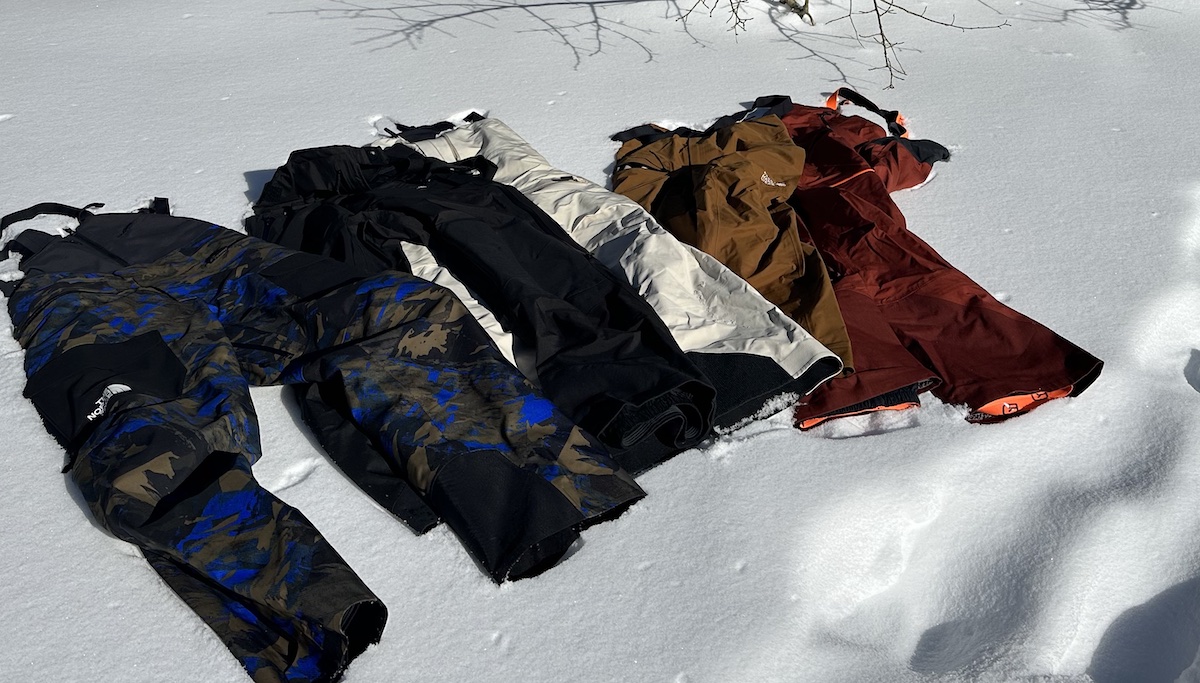
Testing a few of the ski bibs in the insanely light Tahoe powder last season. Photo: Will Sileo/The Inertia
How We Tested The Best Ski Bibs
For this review, we scoured the internet for the best ski bibs on the market, checked in with ski buddies and local pros on the bibs they trust for the deepest of days, and got our hands on over 15 different options from the top outerwear manufacturers in the industry to test out. Lead tester and The Inertia‘s Gear Editor Will Sileo is a lifelong skier with a passion for the best gear in the industry. He took the selected bibs on a tour-de-force during the best winter (2022/23) that Tahoe has seen in years, the perfect testing ground for ski bibs. From backcountry laps, to his favorite powder stashes, to strike missions from the North Cascades to legendary Jackson Hole, he put them to the test.
We first published this review in February of 2023, with the best ski bibs in the industry available at the time. That spring, we tested bibs for the upcoming 2023/24 season, and updated this article in October of 2023 as the first snows began to fall, with the best ski bibs for the 2023/2024 season. We’ve since been testing a variety of ski bibs this 23/24 season, and updated this review in early march to reflect our findings after a season of getting after it on the resort and in the backcountry.
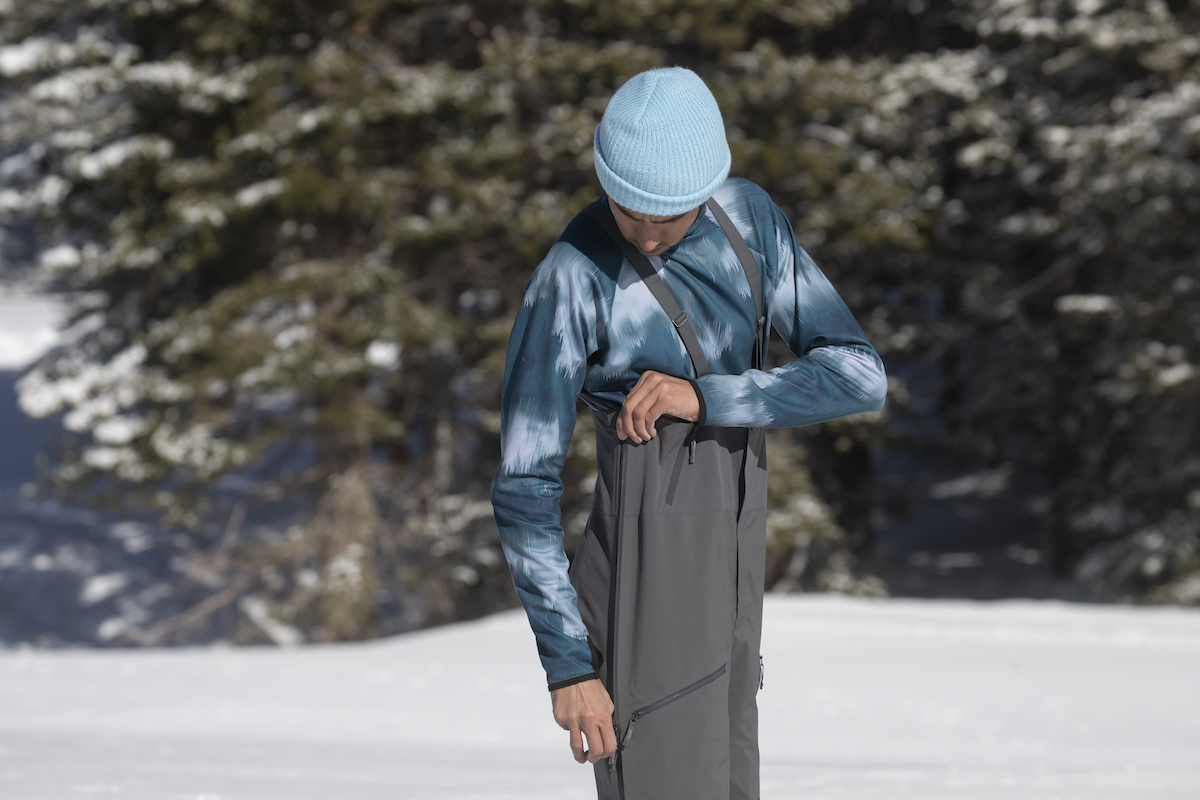
The Arc’teryx Rush bib features full side-zips for uphill ventilation. Photo: Ryan Salm/The Inertia
Ski Bibs Buyer’s Guide
What Features Do I Want an a Pair of Ski Bibs?
Here are some things your bibs should (and all of the ones on this list) have. Ventilation, lots of pockets, drop seat capabilities, and solidly waterproof material.
Ventilation and Breathability
This is one of the most important features in a backcountry bib. Bibs keep you warm, but it’s easy to overheat. Pay attention to the material bibs are made of, as some material is more breathable than others. Some bibs come with mesh-guarded vents to let in cool air but keep out snow. A cool idea, but in our opinion, they don’t let enough air in. The best ventilation in a pair of bibs is full side zippers that let you open up from waist to ankle for full-on airflow. Another great (but rare) feature is inner-thigh vents which, in combination with outer-thigh vents, can really get a cross-breeze going. The Flylow Baker, Backcountry Cardiac, and The North Face Summit bibs have such a four-vent construction.
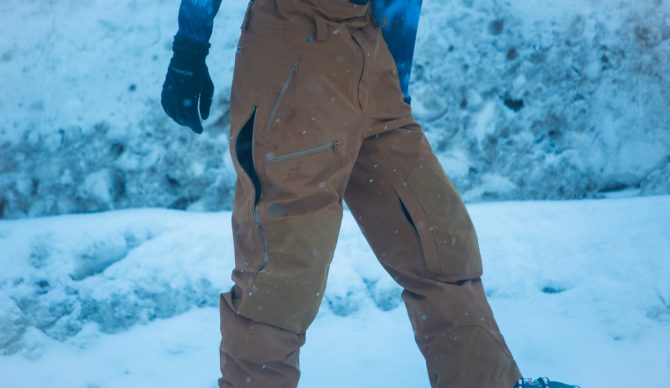
Exterior and interior thigh-vents on the Flylow Baker Bibs allow for cross-ventilation to really cool things down. Photo: Ella Boyd/The Inertia
Pockets (lots of them)
Pockets can be a matter of personal preference, but it’s hard to deny their usefulness. We love to stash all our little gear items (headphones, snacks, avvy beacon, phone, etc.) on ourselves, even when wearing a backpack, to avoid constantly taking the pack on and off to reach what we need. For us, lots of pockets are a must, but we’re not everyone. Pockets (and the bib material necessary to house them) add weight and stiffness, so for those looking to go lighter, lots of pockets can be a downside, and in all likelihood, your jacket will have a number of pockets as well. So pick your poison. Another great pocket feature to look for is internal organization, such as interior stretch pockets and attachment points for lanyards and beacon leashes.

Some ski bibs on this list have three pockets, most have four pockets, The North Face Summit Verbier bibs have six pockets, and the Flylow Bakers have a whopping eight pockets.
Suspender Straps
The biggest con of a few bibs here is their suspender straps and how well they jive (or don’t) with backpacks. Surprising, as you’d imagine. This is something bib manufacturers should have figured out by now. In short, the various types of buckles and attachment points for the straps are often a bit bulky and uncomfortable when worn under a backpack. Our favorite straps system was Arc’teryx’s Rush and Sabre bibs, which use low-profile strap ladders for adjustment, and similarly low-profile clips for bib-strap attachment. Another standout here was the Black Diamond Recon bibs, which use Velcro.
Drop-seat capability
This is a big one. No one likes to take their bibs completely off to go to the bathroom, especially when you have a jacket or other layers over your bibs. Drop seats are either one or two full-side zippers that let you open up the back of your bibs. One side zipper is sufficient, but it means you need to hold the rest of the bib to the side for a successful trip to the loo. For men, a front zipper is a must as well.
Material
It’s tough to strike the right balance between waterproof material, durability, and weight, but luckily, there have been some incredible advancements recently in material technology that have brought these two aspects closer together. GORE-TEX is the top-of-the-line choice, but we were similarly impressed with the performance of proprietary fabrics and waterproof finishes like Black Diamond’s BD.dry, Flylow’s Perm HD fabric, Mammut’s DRYtechnology Pro, among others. On the durability front, it’s all about striking the right balance between lightness and flexibility up against heavyweight durability. Extra reinforcement in key areas, like scuff guards on the ankles, is a key durability feature.
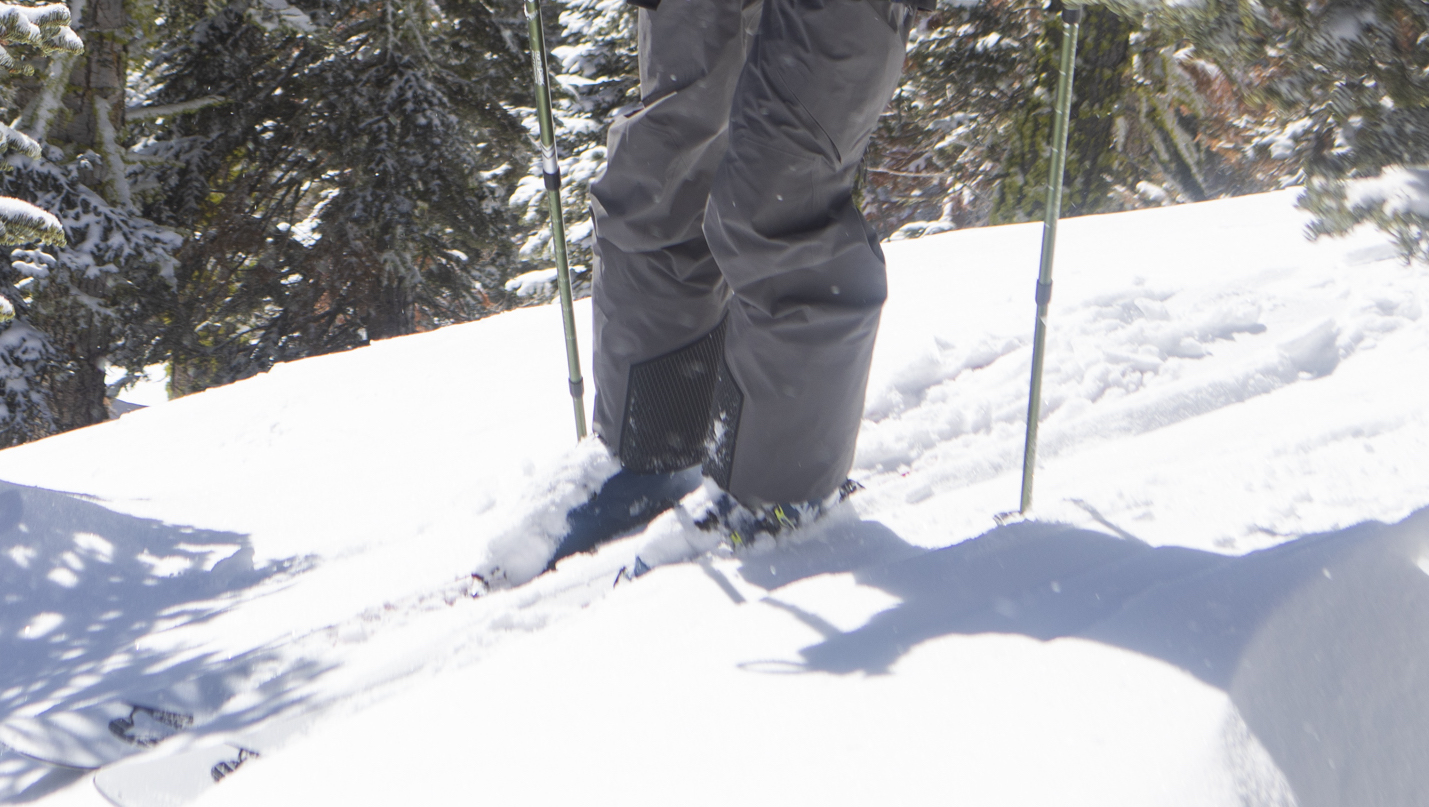
Rubberized scuff patches on the Arc’teryx Rush bibs add a lot of durability in a key area. Photo: Ryan Salm/The Inertia
What’s the Difference Between 2L and 3L Material?
When discussing shell fabric, one of the biggest defining points between higher and lower-quality gear is whether it’s made of a 2L or 3L construction. The terms point to the number of fabric layers sandwiched together to make the outer shell of the garment. Any piece of snowsports outerwear has an outer layer of durable fabric with a waterproof/breathable membrane underneath that keeps water out while letting water vapor (your sweat) to escape.
However, that waterproof membrane needs to be separated from your skin. In a 3L construction, there’s a third layer of fabric fused to the inside of that waterproof membrane. In a 2L construction, there’s still a third layer of fabric, but it’s not fused to the membrane, adding a bit of bulk and usually reducing the breathability, though some 2L ski bibs use a mesh liner.
Having the materials all fused together in a 3L construction adds breathability, a bit more of a streamlined or shell-like feel without that hanging liner, and often a significant uptick in price. That’s great for high-output activities (like heading into the backcountry) but not always necessary if you’re just hitting the resort. That said, for warmer days and hard-charging resort skiing, the added breathability sure is nice.

How water should look on a DWR. If water is soaking into your bibs instead of beading up like so, it might be time to re-up your DWR treatment. Photo: Will Sileo/The Inertia
What’s a DWR Finish?
A DWR (Durable Water Repellant) finish is a waterproof treatment applied to any piece of technical waterproof outerwear. Its main purpose is to keep water from soaking into the first layer of fabric. However, it is actually a bit of a misnomer as said waterproof treatment is often the least “durable” part of the item in question, prone to rubbing off over time. When that happens, water will soak into the first layer of fabric (though it shouldn’t make it past the waterproof membrane beneath), adding weight and chill to your outerwear, neither of which is ideal. If you notice that happening to your ski bibs or other outerwear, it’s worth getting your hands on a spray-on or wash-in treatment to revive the water-repellency of the fabric.
Ski Bib Care
Storage
Properly storing your ski bibs will go a long ways to making sure they last as long as possible. The most important aspect to keep in mind is the DWR will rub off over time, so do your best to hang your ski bibs whenever possible in a warm, dry place.
Washing
While it’s best to minimize the number of times you wash your ski bibs, eventually, the time will come. When it does, be sure to read the tag for proper washing instructions, and avoid normal detergent, as well as hot water. When you wash your ski bibs, it can be a good idea to use an outerwear-specific wash or DWR-reviver like this Nikwax wash-in treatment. That can re-up the water-repellency of your ski bibs without impacting the breathability.

A beacon pocket with a lanyard or attachment point is a great feature to have if heading into the backcountry. Photo: Ella Boyd/The Inertia
Final Thoughts
Any of the ski bibs included in this list would make a great companion out on the slopes. I’ve tested a wide variety of bibs in the past few years, and these are the ones that rose to the top with high-performing materials, great features, and comfy fits. While we do spend a lot of time calling out both pros and cons of the bibs in this review to give you the full picture in making a purchasing decision, overall, we stand behind all of the bibs featured on this list as an incredible option to keep you warm, protected, and performing at your peak while out in the snow.
Return to Top Picks | Return to Comparison Table
Editor’s Note: For Ski Jackets, click here. For women, see our guides to The Best Women’s Ski Jackets and Ski Bibs. For more gear reviews and features on The Inertia, click here.



